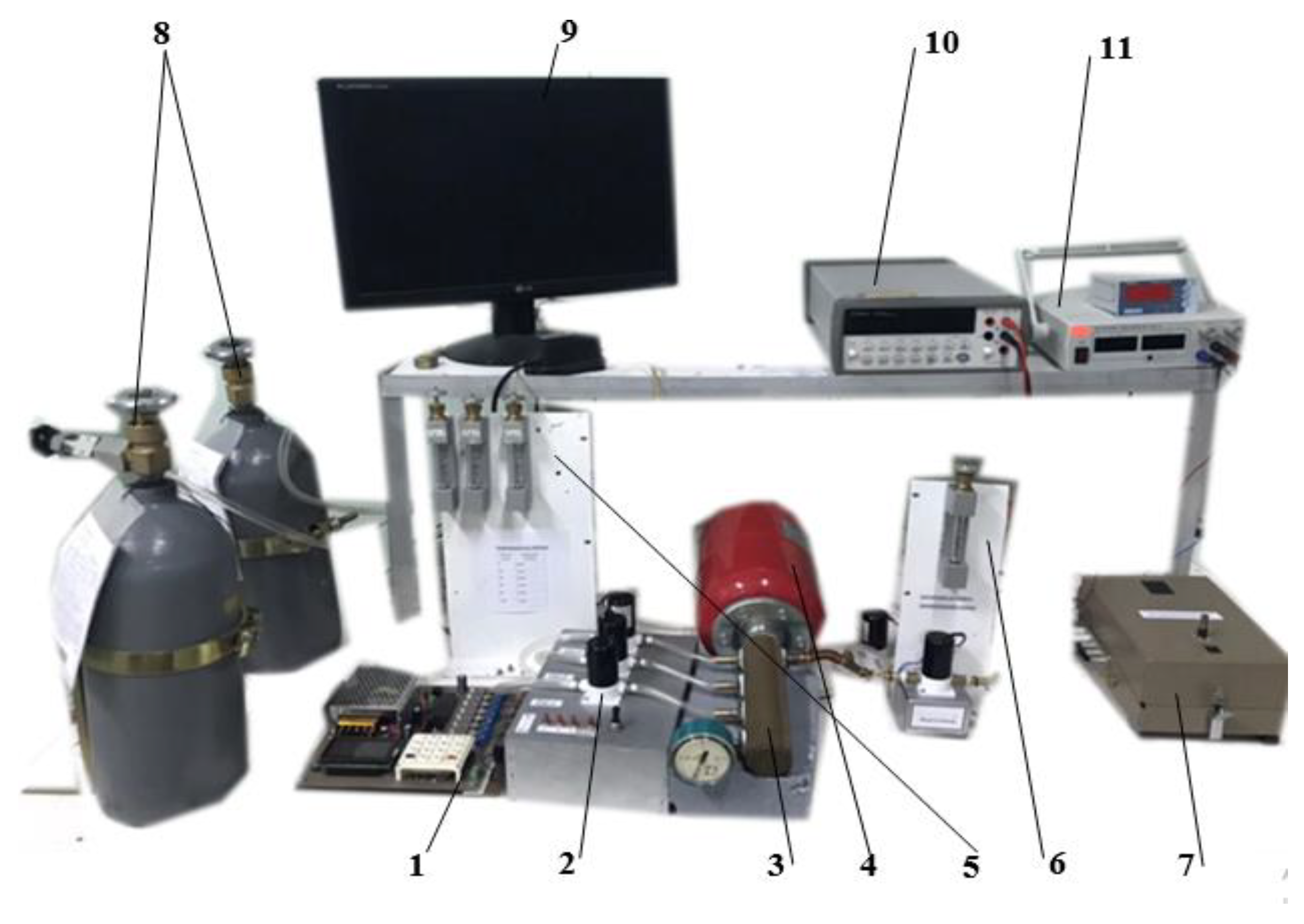The Study of the Structure Based on the Array of ZnO-Nanorods as a Sensor of the Gas Flow Rate †
Abstract
:1. Introduction
2. Materials and Methods
3. Results
Funding
Conflicts of Interest
References
- Ash, J. Sensors of measuring systems. In In 2 book. Book 2; Mir: Moscow, Russia, 1992; 480p, ISBN 5-03-001641-4. (In Russian) [Google Scholar]
- Bradshaw, P. Introduction to Turbulence and Its Measurement; Mir: Moscow, Russia, 1974; 278p. [Google Scholar]
- Kuznetsov, D.N.; Zori, A.A.; Kochin, A.E. Measuring Microprocessor Systems for the Speed and Temperature of Gas and Liquid Flows; DonNTU: Donetsk Oblast, Ukraine, 2012; 226p. [Google Scholar]
- Myasnikov, I.A.; Sukharev, V.Y.; Kupriyanov, L.Y.; Zavyalov, S.A. Semiconductor Sensors for Physico-Chemical Research; Science: Moscow, Russia, 1991; 327p, ISBN 5-02-001542-3. [Google Scholar]
- Samsonov, G.V.; Borisova, A.L.; Zhidkova, T.G. Physical and Chemical Properties of Oxides; Directory. Metallurgy: Moscow, Russia, 1978; 472p. (In Russian) [Google Scholar]
- Pan, Z.; Dai, Z.R.; Wang, Z.L. Nanobelts of Semiconducting Oxides. Science 2001, 291, 1947–1949. [Google Scholar] [CrossRef] [PubMed]
- Kołodziejczak-Radzimska, A.; Jesionowski, T. Zinc Oxide—From synthesis to application: A review. Materials 2014, 7, 2833–2881. [Google Scholar] [CrossRef] [PubMed]
- Wang, Z.L. Piezoelectric Nanogenerators Based on Zinc Oxide Nanowire Arrays. Science 2006, 312, 242–246. [Google Scholar] [CrossRef] [PubMed]
- Kumar, R.; Al-Dossary, O.; Kumar, G.; Umar, A. Zinc Oxide Nanostructures for NO2 Gas–Sensor Applications: A Review. Nano-Micro Lett. 2015, 7, 97–120. [Google Scholar] [CrossRef] [PubMed]
- Nikolaev, A.L.; Kamencev, A.S.; Lyanguzov, N.V.; Petrov, V.V.; Kaidashev, E.M. Design and Study of a High Performance CO Sensor Based on ZnO Nanowires. In Proceedings of the International Conference on Physics, Mechanics of New Materials and Their Applications; Parinov, I.A., Chang, S.-H., Gupta, V.K., Eds.; Nova Science Publishers, Inc.: Hapac, NK, USA, 2017; pp. 441–446. ISBN 978-1-53614-083-5. [Google Scholar]
- Abdullin, K.A.; Bakranov, N.B.; Ismailov, D.; Kalkozova, J.K.; Kumekov, S.E.; Podrezova, L.V.; Cicero, G. Composite materials based on nanostructured zinc oxide. Semiconductors 2014, 48, 471–475. [Google Scholar] [CrossRef]
- Gritsenko, L.; Abdullin, K.; Gabdullin, M.; Kalkozova, Z.; Kumekov, S.; Mukash, Z.; Sazonov, A.; Terukov, E. Effect of thermal annealing on properties of polycrystalline ZnO thin films. J. Cryst. Growth 2017, 457, 164–170. [Google Scholar] [CrossRef]
- Petrov, V.; Starnikova, A.; Abdullin, K.; Makarenko, D. Features of the mechanism of gas sensitivity of the zinc oxide nanorods arrays to carbon monoxide. J. Phys. Conf. Ser. 2018, 1124, 022017. [Google Scholar] [CrossRef]
- Yanpolsky, A.R. Hyperbolic Functions; FIZMATGIZ: Moscow, Russia, 1960; 195p. [Google Scholar]
- Petrov, V.V.; Kamentsev, A.S.; Chetverikov, S.E. Automated Stand for Gas Mixture Formed and Gas Sensors Calibration. In Proceedings of the Abstracts & Schedule 2018 International Conference on “Physics and Mechanics of New Materials and Their Applications” (PHENMA 2017), Busan, Korea, 9–11 August 2018; pp. 183–184. [Google Scholar]
- Petrov, V.V.; Varzarev, Y.N.; Abdullin, K.A. Temperature Dependence of Electrical Properties of ZnO Nanorods Array. In Proceedings of the 2nd International Conference on Informatics, Technology, and Engineering 2019 (InCITE 2019), Bali, Indonesia, 22–23 August 2019; Universitas Surabaya: Surabaya, India, 2019; pp. C37–C40. [Google Scholar]
- Shalimova, K.V. Semiconductor Physics; Energy: Moscow, Russia, 1976; 416p. [Google Scholar]
- Chen, J.; Liu, C. Development and characterization of surface micromachined, out-of-plane hot-wire anemometer. J. Microelectromech. Syst. 2003, 12, 979–988. [Google Scholar] [CrossRef]



Publisher’s Note: MDPI stays neutral with regard to jurisdictional claims in published maps and institutional affiliations. |
© 2019 by the authors. Licensee MDPI, Basel, Switzerland. This article is an open access article distributed under the terms and conditions of the Creative Commons Attribution (CC BY) license (https://creativecommons.org/licenses/by/4.0/).
Share and Cite
Petrov, V.; Starnikova, A. The Study of the Structure Based on the Array of ZnO-Nanorods as a Sensor of the Gas Flow Rate. Proceedings 2020, 42, 42. https://doi.org/10.3390/ecsa-6-06643
Petrov V, Starnikova A. The Study of the Structure Based on the Array of ZnO-Nanorods as a Sensor of the Gas Flow Rate. Proceedings. 2020; 42(1):42. https://doi.org/10.3390/ecsa-6-06643
Chicago/Turabian StylePetrov, Victor, and Alexandra Starnikova. 2020. "The Study of the Structure Based on the Array of ZnO-Nanorods as a Sensor of the Gas Flow Rate" Proceedings 42, no. 1: 42. https://doi.org/10.3390/ecsa-6-06643
APA StylePetrov, V., & Starnikova, A. (2020). The Study of the Structure Based on the Array of ZnO-Nanorods as a Sensor of the Gas Flow Rate. Proceedings, 42(1), 42. https://doi.org/10.3390/ecsa-6-06643



